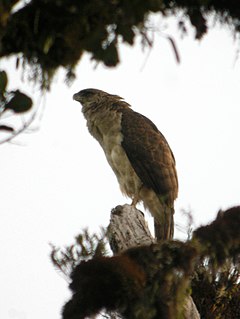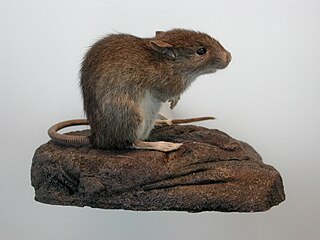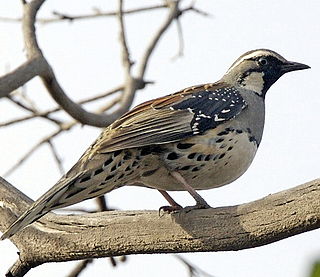
D'Aguilar National Park is a national park in Queensland, Australia. It contains the D'Aguilar Range and is located along the northwest of the Brisbane metropolitan area. The park is traversed by the winding scenic Mount Nebo Road and Mount Glorious Road.

Psophodidae is a family of passerine birds native to Australia and nearby areas. It has a complicated taxonomic history and different authors vary in which birds they include in the family. In the strictest sense, it includes only the 5 or 6 species of whipbirds and wedgebills, but some authors also includes at the quail-thrushes (Cinclosoma), 8 species of ground-dwelling birds found in Australia and New Guinea, and the jewel-babblers (Ptilorrhoa), 3 or 4 species found in rainforest in New Guinea. Others place them in their own family, the Cinclosomatidae. The Malaysian rail-babbler was formerly sometimes placed in this family, which would then be called Eupetidae.

The brown falcon is a relatively large falcon native to Australia and New Guinea.

The logrunners (Orthonyx) are a clade of birds which comprises three species of passerine birds endemic to Australia and New Guinea. Some authorities consider the Australian family Cinclosomatidae to be part of the Orthonychidae. The three species use their stiffened tails to brace themselves when feeding.

The lesser melampitta is a medium-sized enigmatic terrestrial songbird of mountain forests of New Guinea. It is the only species in the genus Melampitta. It is now classified in the family Melampittidae, but in some other sources it is variously considered close to or in the Orthonychidae (logrunners), Paradisaeidae, Corcoracidae, Cnemophilidae (satinbirds) or Monarchidae.

The New Guinea crocodile is a small species of crocodile found on the island of New Guinea north of the mountain ridge that runs along the centre of the island. The population found south of the mountain ridge, formerly considered a genetically distinct population, is now considered a distinct species, Hall's New Guinea crocodile. In the past it included the Philippine crocodile, C. n. mindorensis, as a subspecies, but today they are regarded as separate species. The habitat of the New Guinea crocodile is mostly freshwater swamps and lakes. It is most active at night when it feeds on fish and a range of other small animals. A female crocodile lays a clutch of eggs in a nest composed of vegetation and she lies up nearby to guard the nest. There is some degree of parental care for newly hatched juveniles. This crocodile was over-hunted for its valuable skin in the mid 20th century, but conservation measures have since been put in place, it is reared in ranches and the International Union for Conservation of Nature (IUCN) lists it as being of "Least Concern".

The Papuan eagle is a large bird of prey. It is also known by several other names, including Papuan harpy eagle, New Guinea eagle, New Guinea harpy eagle, or kapul eagle, the latter name from the local name for a usually arboreal, marsupial that the eagle is known to regularly hunt. This is an endemic species to New Guinea, and it can occasionally be found throughout the island. This is a forest-dwelling species, usually occurring in mature rainforest. The Papuan eagle is a fairly little-known species for a large eagle; however, it is known to prey on a wide range of prey, probably by and large mammals and birds from small to quite large sizes. What little study has been conducted about their breeding habits suggests they nest in a large forest tree, perhaps every other year. The Papuan eagle is probably naturally scarce, but it is under the threat of habitat destruction by deforestation, as well as hunting. Due to its small and declining population, the species has been classified as vulnerable by the IUCN.

The New Guinean planigale, also known as the Papuan planigale, is a species of small marsupial carnivore native to the Trans-Fly savanna and grasslands of New Guinea.
The Papuan spine-tailed swift, also known as the Papuan needletail, New Guinea spine-tailed swift or Papua spinetail, is a small, stocky swift with a short, rounded tail and very fast flight. Head and upperparts glossy blue-black, white or whitish belly and undertail coverts, dark underwing with pale central stripe. The small spines at the end of the tail are not visible in flight.

The New Guinean rat is a species of rodent in the family Muridae. It is found only in parts of central Papua New Guinea.

The pygmy longbill or pygmy honeyeater is a species of bird in the family Melanocharitidae. It is one of two species in the genus Oedistoma, which also includes the spectacled longbill. It is found in New Guinea and adjacent islands. Its natural habitats are subtropical or tropical dry forest and subtropical or tropical moist lowland forest.

The Australian logrunner is a species of bird that is endemic to eastern Australia where it uses unique foraging techniques and adaptations to search for its food on the floors of temperate, subtropical, or tropical moist lowland forests in south-eastern Australia. Until 2002, it was widely considered to be conspecific with the New Guinea logrunner, but studies showed the two differ significantly, both genetically and vocally.

The New Guinea friarbird, also known as the Papuan friarbird, is a bird in the Meliphagidae, or honeyeater family. Many taxonomists consider it to be a subspecies of the helmeted friarbird, although some consider it to be a distinct species.

The yellow-bellied longbill or green-crowned longbill is a species of bird in the family Melanocharitidae. It is found in New Guinea. Its natural habitats are subtropical or tropical moist lowland forest and subtropical or tropical moist montane forest.

The Papuan white-eye, sometimes known as the New Guinea white-eye, is a species of bird in the family Zosteropidae. It is found in the Aru Islands and New Guinea. Its natural habitats are subtropical or tropical moist lowland forests and subtropical or tropical moist montane forests. The species was first classified in 1878, and has a conservation status of Least Concern.

The New Guinea snake-necked turtle is a species of turtle in the family Chelidae. The species is found almost exclusively within Western Province, Papua New Guinea.

The Western New Guinea stream turtle or New Guinea snapping turtle is a species of freshwater turtle in the Chelidae family. It is found in the Bird's Head Peninsula and the Bomberai Peninsula west of Cenderawasih Bay, and on the island of Waigeo of West Papua, Indonesia.

The logrunners are two species of birds in the family Orthonychidae. They were previously considered conspecific, but as they differ significantly, they are now generally considered separate species. The family Orthonychidae also contains a third species, the chowchilla.
Orthonyx kaldowinyeri is an extinct species of logrunner from the Late Oligocene to the Miocene of Australia. It was described by Walter Boles from fossil material found at the Last Minute Site of Riversleigh, in the Boodjamulla National Park of north-western Queensland. It was a relatively small logrunner. The specific epithet kaldowinyeri is an Aboriginal term for “old”, referring to the Miocene age of the species which is earlier than that of other members of the genus.

Cinclosomatidae is a family of passerine birds native to Australia and New Guinea. It has a complicated taxonomic history and different authors vary in which birds they include in the family. It includes the quail-thrushes and jewel-babblers.



















